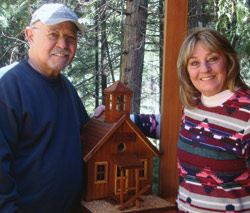Cervical Cancer Survivor
Survivor Inspired Others to Visit the Doctor
 Nanci Stevens worked for 40 years as a telecommunications manager for the third largest law firm in the world. It was during her time there that she received her Stage IIB cervical cancer diagnosis. Thanks to her doctor, family, friends and co-workers, she beat her disease and has been cancer-free ever since. Now, she and her husband build and sell high-end birdhouses, garden benches and custom furniture using cedar from their property in the picturesque Sierra Mountains in northern California. What started as a hobby has since turned into a viable business for the couple.
Nanci Stevens worked for 40 years as a telecommunications manager for the third largest law firm in the world. It was during her time there that she received her Stage IIB cervical cancer diagnosis. Thanks to her doctor, family, friends and co-workers, she beat her disease and has been cancer-free ever since. Now, she and her husband build and sell high-end birdhouses, garden benches and custom furniture using cedar from their property in the picturesque Sierra Mountains in northern California. What started as a hobby has since turned into a viable business for the couple.
Our bodies have a way of giving us warning signs when things aren’t quite right. When I was 46 years old, my warning sign came in the form of unusual vaginal spotting.
It was December 1995. In addition to the abnormal spotting, my periods – when they would come – had also become much more intense. I figured this was all happening because I was starting menopause. While I was definitely approaching the age for it, I wanted to double check with my gynecologist just to be sure. And as luck would have it, my annual Pap smear was already scheduled and not too far away.
At my appointment, I think my gynecologist knew something was wrong right away because he sent my test to the lab for immediate processing. That same night, he called me at home and told me I had cervical cancer—specifically, Stage IIB squamous cell carcinoma.
It all happened so fast. And while it’s never a good time to hear you have cancer, this was particularly difficult because Christmas was just around the corner. Cancer doesn’t wait, though, so I cancelled my holiday plans to deal with it.
Fortunately for me, a senior partner at the law firm where I worked was the current president of the American Cancer Society. He referred me to an oncologist who specialized in my exact cancer type and whose office was just a short flight from my house. I met with him, and we clicked immediately.
My oncologist recommended surgery, so I underwent a radical hysterectomy. I recovered in the hospital for one week, and then at home for another seven weeks. I then started eight weeks of radiation therapy to make sure the cancer was gone. I was treated every weekday during that time.
As a result of the radiation, I developed several silver-dollar-sized blisters on my abdomen, was often exhausted and had bad diarrhea. To get through the tough times, it helped me to think about my treatment like an army—killing all of the bad cells and replacing them with good ones.
From start to finish, the support I received from my husband, family, friends and co-workers helped more than they’ll ever know. They waited in the hospital while I was in surgery, cooked for me after I came home, drove me to doctor appointments and more. You’d be surprised at how many of them scheduled Pap smears for themselves. My diagnosis really drove home that a simple exam could save their lives.
When I was well, I started volunteering for the Bloch Cancer Hotline. As a patient, I had called and had been connected to a former cervical cancer survivor. So when I had the opportunity to instead be on the receiving end of those phone calls, I took it. I’ve met some wonderful people through my service—some I’m still friends with. And what they say really is true: The best medicine is giving back.
Cancer changed the way I look at life; I believe there’s a reason I’m still here. Life will always have its challenges and you never know what it has in store for you. But you do have the power to live each day to its best. Know that cancer is just something you have to get through, and keep your eye on what lies ahead. A positive outlook goes a long way during treatment and recovery.


